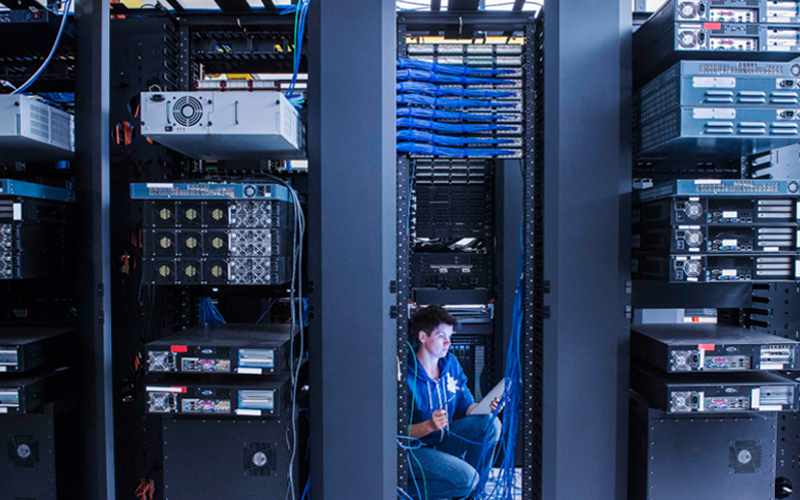In a connected world, processing data at real-time is becoming increasingly important, and this is where edge computing comes into play. Technologies such as artificial intelligence (AI), machine learning (ML) and the Internet of Things (IoT) enable real-time decision making for critical applications in several industries. Being able to process this data at a site that is close to data generation becomes necessary in order to reduce latency and improve efficiency. For instance, autonomous vehicles need to make split-second decisions in traffic based on several inputs from sensors and cameras.
With edge computing, data can be processed closer to the point of data collection. Billions of devices are connected on the internet, and interconnected internet service providers (ISPs), who form the backbone of the internet, manage the immense amount of data being transmitted. The ‘edge’ of the internet constitutes the servers, IoT devices, workstations and various mobile devices that are connected to the local internet infrastructure. Critical applications need to be able to process data reliably in real-time. In edge computing, the processing power lies in physical proximity to the source of data. Cloud-like servers may be present in the last mile of the data infrastructure, or the processing may happen on the device itself. This reduces the time taken for data transmission and that significantly improves efficiency.
Types of edge data centres
Edge data centres are always in close proximity to the edge network, i.e the users and the network of devices form part of a larger edge computing infrastructure. An edge data centre typically functions like an internet exchange point for internet devices, networks and service providers for localised computing resources. Edge data centres are especially needed for time-sensitive applications, since they can respond much faster as they are scaled to specific requirements. They also offer edge caching that lets applications store data temporarily.
Edge computing data centres can be deployed in a large variety of environments, and can be present at different physical locations.
- On-premises edge data centres are typically deployed at customer premises and are co-located in the existing data centre. These micro data centres could be a couple of racks or servers, or even a mini data centre, depending on the requirements.
- Tower edges refer to the data centres located at towers owned by telecom operators, and are perfect for applications that require last mile connectivity. Real-time critical applications such as autonomous cars require high and accurate responsiveness, and tower edges offer the perfect solution as they have both connectivity and power.
- Wireline telecom central offices enable convergence of old telephone lines and cable, and form part of the outer edge of the network.
- The inner edge comprises the mobile core network, and is located close to major cities to provide services to customers. Ultimately wireline telecom and wireless infrastructure must converge to enable next generation data services.
- Regional edges are carrier-neutral and offer colocation by hosting several customers. These can typically serve large workloads for different types of customers who can rent out racks, or even the entire data centre.
Why an edge data centre strategy is required
Edge computing solutions offer several advantages over traditional cloud computing. Edge data centres offer lower latency, typically between five and twenty milliseconds, which result in quicker response times, and that improves user experience. This is especially true for applications that are driven by real-time decision making, such as, smart grids, real-time monitoring of enterprise assets or patient monitoring.
Due to proximity to the data source, edge data centres also help enterprises realise reliable data transmission. With some of the data processing taking place at the edge data centre, there is reduced consumption of both resources and bandwidth. Fewer cloud uploads, reduction in the amount of sensitive data being transmitted, and lowered exposure to network vulnerabilities result in improved data security. With storage and computing being closer, there are fewer high-cost interconnection hubs and lowered demand for bandwidth, helping to save on operating costs. With edge data centres being offered as a managed service, companies can lower the total cost ownership as well.
Challenges to be considered
As enterprises pursue an edge computing strategy, they must be aware of the challenges. Edge data centres can result in a complex distributed computing environment, with several physical locations requiring experienced resources and a comprehensive security plan to manage the edge infrastructure. Enterprises also need to be able to keep low latency to meet performance expectations. As the network continues to grow, transmission between the edge data centre and the cloud data centre can result in higher bandwidth consumption and reduce performance.
To develop a robust and scalable edge computing strategy, enterprises must consider the physical location of the edge centre that enables high connectivity and minimises latency. The edge data centre must be able to handle and process high data volumes and minimise transmission to the cloud data centre. While older cloud data centres are built for specific purposes of the organisation and are needed to process heavy workloads, edge data centres can easily adapt to new technology and infrastructure, and instantaneously provide data on demand for real-time decision making.
How can Infosys BPM help?
Infosys BPM’s Wireline Telecom Service offerings include solutions for enterprises seeking to transform and thrive in a rapidly changing ecosystem. We assist businesses in building robust edge computing strategies and creating specific edge computing solutions that manage increasingly complex data demands, optimise network performance, minimise disruptions and maximise service availability.







